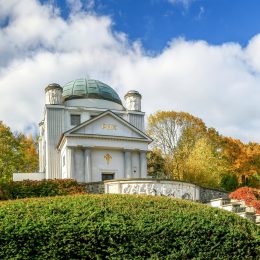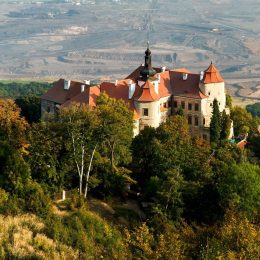The best view is always from the sky.
The distinctive landmark of the town which is visible from afar is Hněvín castle. It is a popular place for visitors with panoramic views of the countryside from the Krušné Mountains to the Central Bohemian Highlands. On its premises is accommodation and a restaurant. The castle tower serves as a view-tower. There is also an observatory open to the public as well as an open-air theatre stage.
Master Edward Kelley’s Workshop
The adventurous exhibition featuring Master Edward Kelley´s Workshop in the castle area is mainly designed for the youngest visitors. And it will certainly not be boring for their company. In the workshop, you can reveal the secrets of the most famous tricks, which the alchemist used to astound the Emperor himself. Edward Kelley, the Court alchemist of Emperor Rudolf II, was imprisoned in Hněvín in 1596. A year later, he died there after he attempted to escape from the castle’s dungeon. Legend has it that before his death he cursed Hněvín castle and the town. With some exaggeration, we can say that the curse was fulfilled. When old Most disappeared from the face of the earth due to the coal mining.
Events organized at the castle
Among the events that are held in the castle, the most popular is Master Edward Kelley´s Day, held annually in June. Visitors can see funny performances by magicians and wizards, illustrations of historical crafts and performances from the Most theatre ensemble on the open-air theatre stage.
- hrad Hněvín
- hrad Hněvín
- hrad Hněvín
- hrad Hněvín
Panoramatic photo of the Castle Hněvín
Panoramatic photo of the Castle Hněvín – west view
Panoramatic photo of the Castle Hněvín – ost view
The history of the castle
The Most castle was built on the Castle Mountain (Hněvín). An archaeological survey showed the remains of the walls in the 9th century but the stone castle was built probably by the House of Hrabišic, who were the owners of Most in the 12th century. During the course of several centuries, the owners of the castle changed many times until it was sold in 1595 by Rudolf II to the town of Most. The relatively peaceful possession of the castle and its estates lasted until the Thirty Years War.
In 1646, it was conquered by the Swedes who use a trick to take it and then imposed large fines as well as large fees on the town. The imperial army besieged the castle for a year and a half. However, it remained in the hands of the Swedes. The Most burgesses was blamed for the misfortune the castle since her “importance” always attracted enemies. Therefore, Emperor Ferdinand III allowed the demolition of the castle, which began in 1651. The castle mountain was desolated and on its foot remained vineyards and gardens.
Present days
At the end of the 19th century, on the site of the original castle, a replica was built which has served from the beginning as a restaurant and a view-tower. The current look of the castle comes from the year 1927 and in 2000-2001 the castle underwent a costly renovation.





















